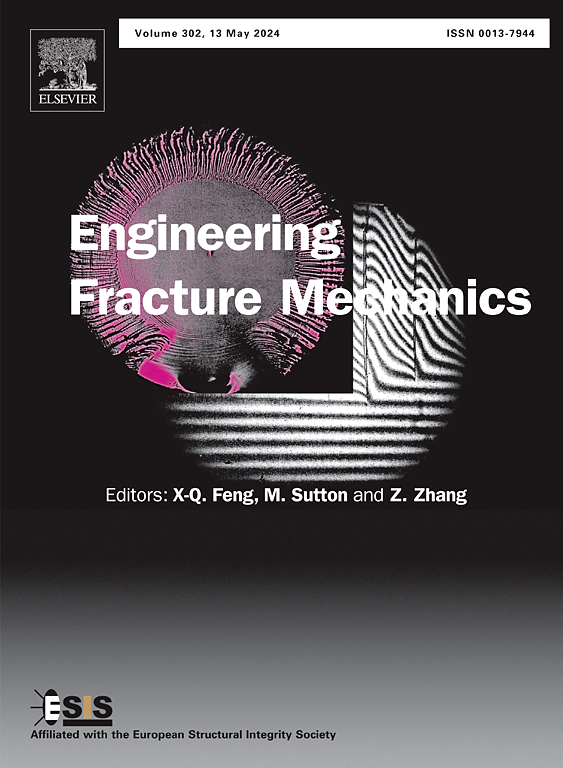开挖诱发的碎屑岩开裂:不同初始损伤程度的真正三轴瞬时卸载研究
IF 5.3
2区 工程技术
Q1 MECHANICS
引用次数: 0
摘要
深部工程中的开裂和挤压问题严重制约着工程建设。为揭示岩石在瞬时卸载作用下的开裂机理,利用自行设计的刚性真三轴试验装置,配备了开创性的电磁卸载和高速摄像功能,对不同初始损伤程度的碎屑岩进行了瞬时卸载试验。结果表明,样品在瞬时卸载过程中会发生严重且不可逆的横向扩张,在初始损伤程度较高时,扩张应变会迅速增加。瞬时卸载诱导产生大量拉伸微裂缝,这些裂缝迅速扩展和凝聚。裂纹的扩展速度以及破坏时裂纹的长度和宽度随着初始损伤程度的增加而增加。样品最终呈现出两个明显的宏观断裂带:拉伸断裂带和拉伸剪切混合断裂带。声发射命中率和能量分析表明,较高的初始损伤水平对应较大的卸载损伤,整个实验过程中拉伸裂纹的总体比例较高。在爆破开挖的诱导下,径向应力迅速卸载,紧邻的围岩中出现密集的拉伸裂缝,导致开裂并向自由面挤压。重要的是,较高的初始损伤程度会加剧挤压效应。自主研发的设备是研究开挖卸荷的重要技术工具,该研究得出的见解为了解开裂机理和指导深层工程项目施工提供了宝贵的指导。本文章由计算机程序翻译,如有差异,请以英文原文为准。
Excavation-induced cracking of clastic rock: A true triaxial instantaneous unloading study with varied levels of initial damage
The cracking and squeezing problem in deep engineering significantly constrains project construction. To reveal the cracking mechanism of rock under instantaneous unloading, a self-designed rigid true triaxial experimental apparatus, equipped with groundbreaking electromagnetic unloading and high-speed camera functions, was utilized to conduct instantaneous unloading tests on clastic rock with varied levels of initial damage. The results indicate that samples undergo severe and irreversible lateral dilation during instantaneous unloading, with dilational strain rapidly increasing at higher initial damage levels. Instantaneous unloading induces the generation of numerous tensile microcracks, which propagate and coalesce rapidly. The crack propagation speed, as well as the length and width of the cracks at failure, increase with the rise of the initial damage level. The samples eventually exhibit two distinct macroscopic fracture zones: a tensile fracture zone and a tensile-shear mixed fracture zone. Analysis of acoustic emission hits and energy indicates that higher initial damage levels correspond to greater unloading damage, with a higher overall proportion of tensile cracks throughout the experiment. Under the induction of blasting excavation, radial stress is rapidly unloaded, and dense tensile cracks emerge in the immediate surrounding rock, leading to cracking and squeezing towards the free face. Importantly, higher initial damage levels intensify the squeezing effect. The self-developed equipment serves as a crucial technical tool for researching excavation unloading, and the insights derived from this study provide valuable guidance for understanding cracking mechanisms and informing the construction of deep engineering projects.
求助全文
通过发布文献求助,成功后即可免费获取论文全文。
去求助
来源期刊
CiteScore
8.70
自引率
13.00%
发文量
606
审稿时长
74 days
期刊介绍:
EFM covers a broad range of topics in fracture mechanics to be of interest and use to both researchers and practitioners. Contributions are welcome which address the fracture behavior of conventional engineering material systems as well as newly emerging material systems. Contributions on developments in the areas of mechanics and materials science strongly related to fracture mechanics are also welcome. Papers on fatigue are welcome if they treat the fatigue process using the methods of fracture mechanics.

 求助内容:
求助内容: 应助结果提醒方式:
应助结果提醒方式:


